Hoya Plant Care: How to Grow Hoya Varieties (Wax Plant)
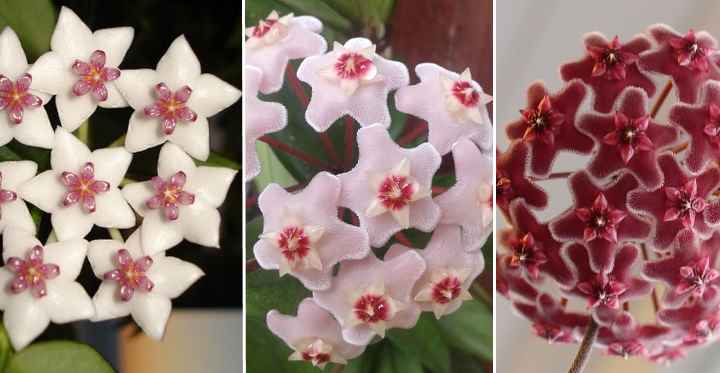
Hoyas (wax plants) are flowering tropical succulents that are grown indoors as houseplants. Hoya plants are well-known for their waxy evergreen leaves, porcelain-like flowers, and long trailing stems. Other names for hoyas include wax plant, waxi flower, porcelain flower plant, wax vine, and honey plant. Hoyas are easy to care for houseplants. Wax plants thrive in average room temperatures and have very few care requirements.
There are around 300 species of Hoyas that belong to the family Apocynaceae. These perennial creeping vine plants are native to Asia and Australia, where they grow in tropical and subtropical rainforests. Hoyas usually grow up trees where their roots cling to the tree surface.
As indoor plants, most species of hoya grow well in hanging baskets. Their trailing vines provide lush, succulent greenery to add a touch of nature to any room.
How to care for hoya plants (wax plants): Place your hoya in a bright location, but away from direct sunlight. Hoyas grow best in temperatures between 60 and 80°F (16 – 27°C) and need high humidity. Soil should be well-draining, and they only need watering when the soil partly dries out.
When hoyas flower, they produce clusters of small colorful star-shaped flowers that can be white, pink, red, purple, or lavender colors. A few species of hoyas have yellow or orange flowers with dark red or black centers.
In this article, you will find a detailed guide on how to care for these “waxi plants.” First, let’s look at some of the most popular varieties of hoyas.
Hoya Plant Types
Here are a few types of hoyas if you want to grow beautiful evergreen wax plants at home.
Hindu rope plant (Hoya carnosa compacta)
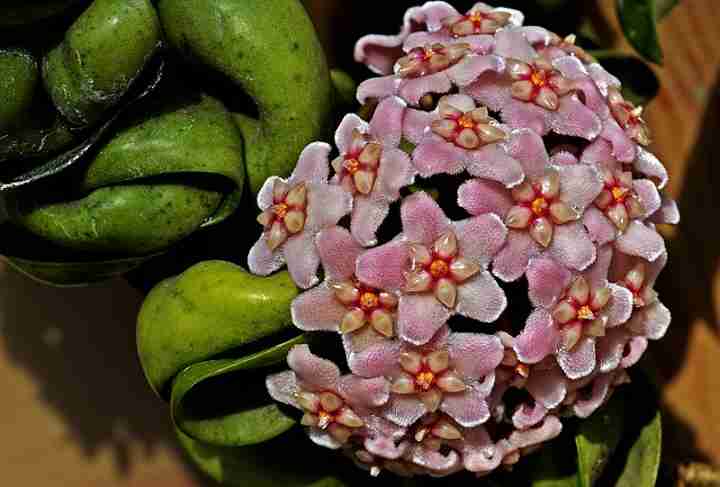
Also called Krinkle Kurl due to its twisted green leaves, this hoya has trailing leafy stems and produces pink flowers in spring and summer.
Tricolor hoya (Hoya carnosa ‘Variegata’)
This charming houseplant has stunning variegated green, white, and pink leaves. The two most well-known hoya tricolor plants are hoya krimson queen and hoya krimson princess.
Narrow-leaf hoya (Hoya kentiana)
The unique feature of this indoor houseplant is its long narrow leaves and bushy appearance.
Shooting stars (Hoya multiflora)
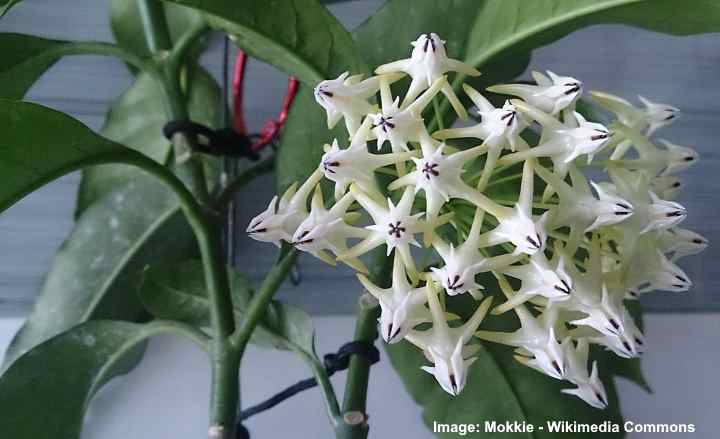
Large lanceolate glossy leaves and beautiful star-shaped flowers make this plant an attractive feature for any room in your home.
Variegated rope plant (Hoya carnosa ‘Crispa Variegata’)
This houseplant has long creeping stems with succulent twisted green and yellow variegates leaves. This variety is also called a Hindu rope plant.
Wax plant (Hoya linearis)

This species of hoya has long hairy, dark green leaves and beautiful clusters of pure white, star-shaped flowers.
Hoya obovata
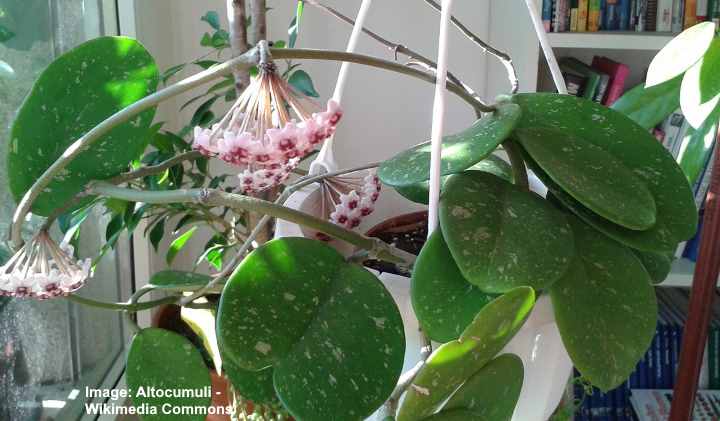
Thick green waxy leaves with speckles of white and pink are the most attractive features of this flowering succulent.
Hoya Flowers

In the picture from left to right: Hoya bella, Hoya carnosa and Hoya pubicalyx
With the right care, temperature, and humidity, your hoya can produce stunning flowers. The flower heads are made up of star-shaped flowers that form an attractive dome. The delicate white flowers on many hoya species are a reason why they are also called porcelain flower plants.
Looking at pictures of hoya flowers, you will notice a stunning array of vivid colors. Beautiful shades of pinks and reds are the most common colors. However, hoya flowers also bloom in dark red, orange, green, and purple colors.
For example, the waxflower plant Hoya pubicalyx has cultivars producing flowers in almost any shade imaginable.
Hoya Plant (Wax Plant) Toxicity
The good news about growing hoyas indoors is that they are not poisonous and won’t harm pets, animals, or children.
Hoya Pests

Hoya calycina
All species of hoyas are on the list of easy-to-care-for houseplants, and they are quite resistant to bugs. As with most houseplants, pests such as mealybugs, scale insects, and whitefly can affect your plant.
Most hoyas are flowering plants such as Hoya carnosa and Hoya calycina that also produce a lot of nectar. When the plants bloom, you may notice more problems with aphids.
Usually, regular treatment with a natural organic neem oil spray is enough to get rid of pests from your evergreen plants.
Propagating Hoya Plants
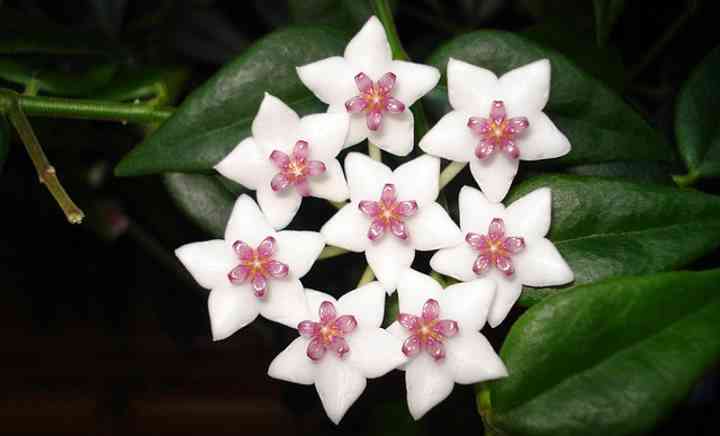
Hoya bella
One of the great things about growing hoyas at home is that they are easy to propagate. The easiest species of hoya to reproduce are the vine varieties such as Hoya carnosa, Hoya curtisii, and hoya rope plants.
When pruning your hoya, you can take cuttings with 2 or 3 nodes on them. Root the cuttings by placing the cut ends it in a small jar of water. After a few weeks, you should notice new roots growing. Later in the article, you will find out what is the best type of soil for growing hoyas.
You can also put the cutting directly into potting soil. Enclose the pot with a plastic bag to increase humidity and keep the soil moist. It should root after four weeks when you can remove the plastic covering.
How to Prune Hoya
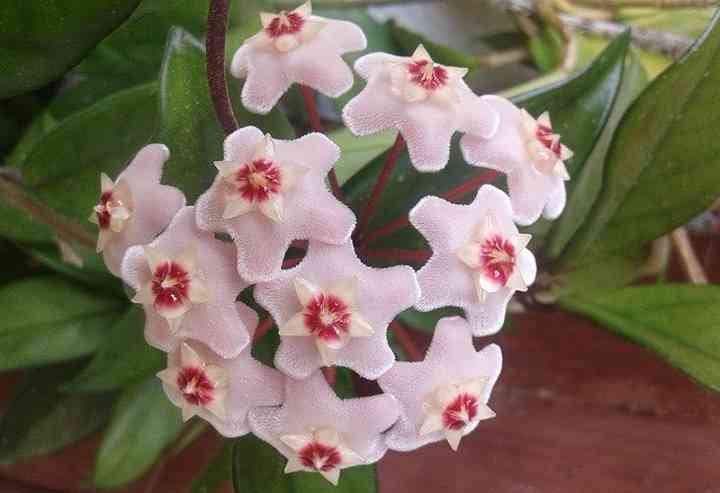
Hoya carnosa
If left to their own devices, hoyas can become leggy vines and can look unkempt. Pruning helps to encourage growth and give the hoya vine a bushier appearance.
To prune your hoya, cut back any brown or dead stems. With leggy, vigorous stems, you should prune them at the node.
Because hoyas are a type of milkweed plant, you will notice a white milky latex substance ooze from the stem. This is normal.
You should take care when pruning so as not to cut off the peduncle. This is the stem where the flowers grow. Leaving this flowering stem will help ensure that your houseplants produce colorful flowers year after year.
How to Care for a Hoya Houseplant
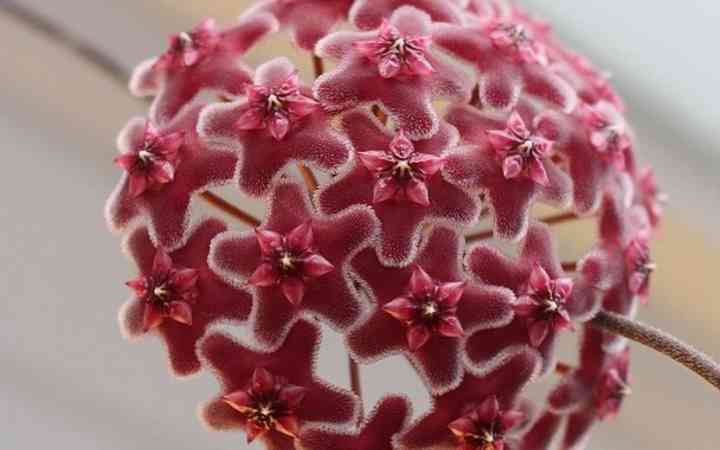
Hoya pubicalyx
Although wax plants are easy to grow, there are a few things to keep in mind to help them thrive. The native environment of hoyas is in tropical rainforests in Asia. Thankfully, you don’t have to turn your room into a humid, damp place to successfully grow wax plants.
Read on to find out the best care tips that ensure hoyas thrive indoors.
Hoya Light Requirements
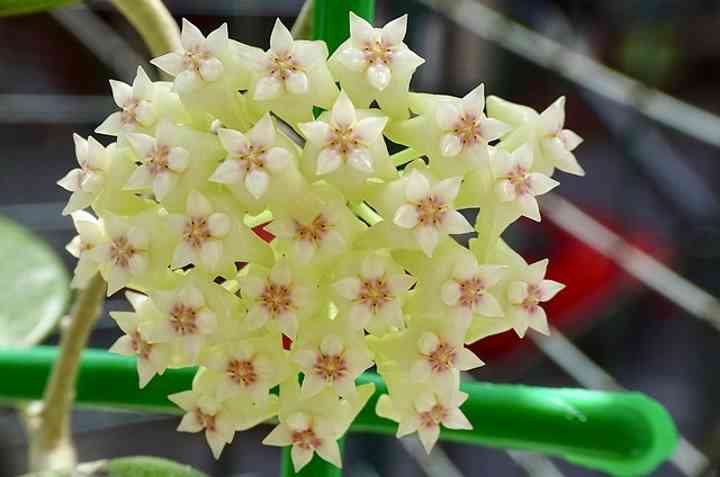
Hoya Vitellinoides
Hoyas need to grow in bright, indirect sunlight. They need around 6 hours of sunshine daily. Hoyas also grow in shady conditions or rooms with medium light, but they will rarely flower in those conditions. The best place for your hoya is in a south- or west-facing room.
When caring for your hoya, keep an eye on the color of the leaves. You may notice that leaves on the sunny side look healthier or start to yellow (if there’s too much direct sunlight). If this is the case, rotate your plant every few months to give your plant the best care.
During warm summers, you can place your hoya outdoors. As long as the temperature doesn’t drop below 50°F (10°C), your wax plant shouldn’t suffer any lasting damage. Just remember to put the plant outdoors in a partial-shady place where it’s protected from direct sunshine.
How to Water a Hoya Wax Houseplant

Hoya aldrichii
The best care tip for watering a hoya is to wait until the top 1” (2.5 cm) of the soil has dried out. How often you should water a hoya depends on the air temperature and humidity. To water, pour enough water until it drains out the bottom of the pot.
The worst thing you can do for a hoya plant is to over-water it. A hoya plant that sits in damp, soggy soil is prone to root rot and dying due to fungal diseases. Ensure that your pot or container has drainage holes in the bottom. Adding a layer of pebbles will help increase drainage and airflow.
A tell-tale sign that you are over-watering a hoya is yellowing leaves that feel mushy. If you notice yellow leaves and the soil is very damp, hold off watering until the soil partly dries out. In some cases, you may have to repot your hoya to save it from dying completely.
One important watering tip for hoyas is never to allow them to sit in a tray or saucer of water. You will end up with waterlogged soil, diseased roots, and fungal problems.
Best Temperature for Growing a Hoya
Hoyas grow well and thrive in temperatures between 60 and 80°F (16 – 27°C). So, average room temperatures are perfect for hoya vines. To ensure a hoya isn’t stressed, avoid sudden temperature changes. Keep healthy houseplants away from cold drafts or hot radiators.
Your hoya carnosa and other species of hoyas will also grow in cooler or warmer temperatures. The absolute minimum temperature is 50°F (10°C), and the maximum is 95°F (35°C).
Humidity Requirements for Hoya Plants
Hoyas need high humidity levels to thrive indoors. Anything between 60 and 80 percent humidity seems ideal for healthy hoya plant growth and foliage. To care for humidity, spray a fine mist on the leaves every day, use a humidifier, or place on a pebble tray with water.
If you have succulent varieties of hoyas such as Hoya carnosa ‘Crispa,’ ‘Regalis,’ (rope plants), or a mini wax leaf hoya (Hoya lacunosa), you don’t need to worry too much about humidity. The thick, waxy leaves hold in plenty of moisture.
If you have thin-leafed hoyas such as Hoya bilobata, Hoya kentiana, Hoya curtisii, or a tricolor hoya, you need to pay more attention to humidity levels.
Keeping humidity just right for your hoya also depends on the air quality. Household heating tends to dry the air. So, in winter, you may need to mist your plants twice a day. Some species of hoyas are more challenging to care for than others, so consider this.
Signs that you need to increase humidity are withered leaves or weak growth. Make sure that the soil is slightly damp and give the leaves a good misting to help boost humidity.
The Best Soil for Hoyas
Hoyas need well-draining soil, sphagnum moss, or orchid substrate for the best growth. The right potting mix for hoyas is one-part peat, one-part perlite, and one-part orchid mix. This type of soil ensures plenty of airflow to keep the roots healthy and prevent them from drying out.
Hoyas are a type of epiphytic plant, which means that they can grow on the surface of other plants—trees, large shrubs, and bushes. The roots absorb nutrients from the air or the host plant.
You can also grow hoyas in coco chips, bark chips, or sphagnum moss. In this case, you will need to water your hoya more frequently to avoid the roots becoming too dry. Another suitable type of soil for growing hoyas is a cactus mix or potting medium for succulents.
Repotting/Transplanting a Hoya Plant
Hoyas are not fast-growing plants, so you don’t need to repot them often. Hoyas grow best when they are left alone in the same pot. Thus, only repot your hoya when you notice it has stopped growing or there are drainage problems due to being rootbound.
If you need to repot your wax plant, choose a pot that is 1” to 2” (2.5 – 5 cm) wider than its current one. Gently remove the plant from its existing pot and shake off excess soil. Check the root system for soggy, dead, or shriveled roots and prune as necessary.
Repot your hoya in a new pot with a fresh potting medium. Thoroughly water and place in a bright, sunny location to encourage healthy growth.
The best time to repot a hoya is in spring or early summer when it’s at is healthiest.
How to Feed a Hoya Plant
Wax plants don’t require a lot of care when it comes to fertilizer. In the growing season—spring and summer—fertilize every 2 or 3 weeks with an organic fertilizer. In the fall and winter, you can hold off feeding as the plant growth becomes almost dormant.
As your hoya is maturing, a nitrogen-rich fertilizer will encourage healthy growth. When you notice that your plant is about to bloom, switch to a phosphorus-rich fertilizer to get healthy, vibrant flowers.
To care properly for your hoya, and prevent root burn, flush the soil between feeding. You can do this by thoroughly watering your succulent houseplant and allowing all excess water to drain. This flushing helps avoid a buildup of mineral salts in the soil which could hinder growth.
Hoya Plant Problems
Wax plants are generally forgiving when it comes to caring for them. But there are a few common problems that can affect all varieties of hoyas.
Hoya leaves turning yellow or brown color
Unless you have a variegated hoya plant or a tricolor hoya, the leaves should be a lush, healthy green color.
Leaves turning brown or red could be a sign of leaf burn and too much sun. The solution is to move your hoya away from a window or protect it from direct sunlight.
Leaves that become yellow could be a sign that they are old. If you only occasionally have one or two yellow leaves, you have nothing to worry about.
However, if many leaves start turning yellow, it is probably because you are over-watering the plant. To save your hoya, repot it, and in the future, only water it when the soil has partly dried out.
Wax plant leaves that fall off or wither
Drooping leaves, leaf drop, or dried leaves are signs of under-watering your hoya. Revive your hoya by giving it hoya a thorough watering. During spring and summer, check your hoya every week to see if it needs watering. You need to water less often in fall and winter.
Limp leaves are also a sign that the roots have died due to over-watering. Take some cuttings from healthy stems and propagate a new plant.
If the soil is slightly moist, leaf drop could be a result of your tropical houseplant being in a cold draft.
Hoya plants that don’t flower
Hoyas need plenty of bright light to encourage flowering. So, keep your plant in a sunny location all year long to encourage blooming.
Other reasons for a lack of flowering blooms are nutrient deficiencies and not allowing the soil to dry out enough.
Related articles:
